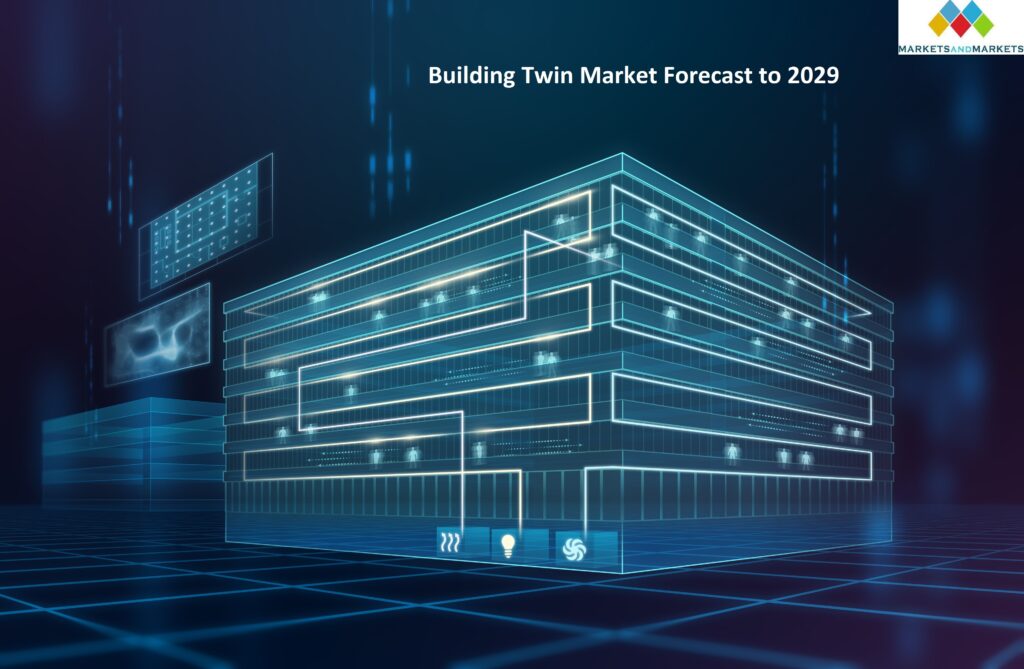The global Building Twin market is on the brink of explosive growth, with its size projected to increase from USD 2.1 billion in 2024 to an impressive USD 13.3 billion by 2029. This represents a staggering CAGR of 44.7% during the forecast period, underscoring the transformative impact of digital twins on the construction and real estate industries.
What is a Building Twin?
A Building Twin is a digital replica of a physical building, encompassing all its systems, processes, and performance data. This virtual model allows for real-time monitoring, simulation, and optimization throughout the building’s lifecycle, from design and construction to operation and maintenance. Building Twins integrate data from various sources, including IoT devices, sensors, and historical records, to create a comprehensive and dynamic digital representation of the building.
Download PDF Brochure:
https://www.marketsandmarkets.com/pdfdownloadNew.asp?id=195753377

Market Drivers: What’s Fueling the Building Twin Market Growth?
- Increased Demand for Smart Buildings: The rise of smart buildings, which utilize technology to improve efficiency, comfort, and sustainability, is a major driver of the Building Twin market. Digital twins enable the continuous monitoring and optimization of building performance, helping to reduce energy consumption, minimize maintenance costs, and enhance occupant comfort.
- Urbanization and Infrastructure Development: Rapid urbanization and the need for modern infrastructure are pushing the demand for advanced construction technologies. Building Twins offer a powerful tool for managing the complexities of large-scale urban developments, from planning and design to construction and operation.
- Regulatory Compliance and Sustainability Goals: As governments and organizations worldwide focus on sustainability and environmental regulations, Building Twins provide a means to monitor and ensure compliance with these standards. The ability to simulate different scenarios and predict outcomes is particularly valuable in meeting energy efficiency and carbon reduction targets.
- Cost Efficiency and Risk Mitigation: The use of Building Twins can lead to significant cost savings by identifying potential issues before they become costly problems. Through predictive maintenance and simulation of various scenarios, Building Twins help reduce the risks associated with construction and building management.
Market Segmentation: Understanding the Dynamics of the Building Twin Market
- By Component: The Building Twin market can be segmented into software, services, and platforms. The software segment, which includes modeling, simulation, and data analytics tools, is expected to hold the largest share. However, the services segment, including consulting, implementation, and maintenance, is projected to grow rapidly as more organizations adopt Building Twin technology.
- By Application: Key applications of Building Twins include energy management, asset management, building automation, and predictive maintenance. Energy management is a dominant application, driven by the need for energy efficiency and sustainability in modern buildings. Asset management and predictive maintenance are also gaining traction, as they offer substantial cost savings and improved operational efficiency.
- By End-User: The major end-users of Building Twins include commercial buildings, residential buildings, and industrial facilities. Commercial buildings, such as offices, shopping malls, and hotels, are the largest consumers of Building Twin technology, as these facilities require complex systems management and energy optimization. The industrial sector, including manufacturing plants and warehouses, is also a significant market, driven by the need for efficient operations and maintenance.
- By Region: The Building Twin market is geographically segmented into North America, Europe, Asia-Pacific, and the Rest of the World. North America and Europe currently lead the market, thanks to their advanced technological infrastructure and strong focus on sustainability. However, the Asia-Pacific region is expected to witness the highest growth, fueled by rapid urbanization, industrialization, and smart city initiatives in countries like China, India, and Japan.
Challenges and Opportunities in the Building Twin Market
Challenges:
- High Initial Costs: The implementation of Building Twin technology requires significant upfront investment in software, hardware, and skilled personnel. This can be a barrier for smaller organizations or those with limited budgets.
- Data Management and Integration: Managing the vast amounts of data generated by Building Twins and integrating it with existing systems can be challenging. Ensuring data accuracy, security, and interoperability is crucial for the effective use of digital twins.
- Lack of Standardization: The Building Twin market is still relatively new, and there is a lack of standardized protocols and best practices. This can lead to inconsistencies in implementation and performance across different projects.
Opportunities:
- Innovation in AI and Machine Learning: The integration of artificial intelligence (AI) and machine learning with Building Twin technology presents significant opportunities for enhancing predictive capabilities and optimizing building performance.
- Expansion into Emerging Markets: As the demand for smart buildings and sustainable infrastructure grows in emerging markets, there is significant potential for the expansion of Building Twin technology in regions such as Asia-Pacific, Latin America, and Africa.
- Partnerships and Collaborations: Strategic partnerships between technology providers, construction companies, and real estate developers can drive the adoption of Building Twins and accelerate market growth.
The Future Outlook of the Building Twin Market
The future of the Building Twin market looks exceedingly bright, with rapid growth expected over the next decade. As more organizations recognize the value of digital twins in optimizing building performance, reducing costs, and achieving sustainability goals, the demand for this technology will continue to rise. The integration of emerging technologies such as AI, IoT, and blockchain will further enhance the capabilities of Building Twins, making them an indispensable tool in the construction and real estate industries.